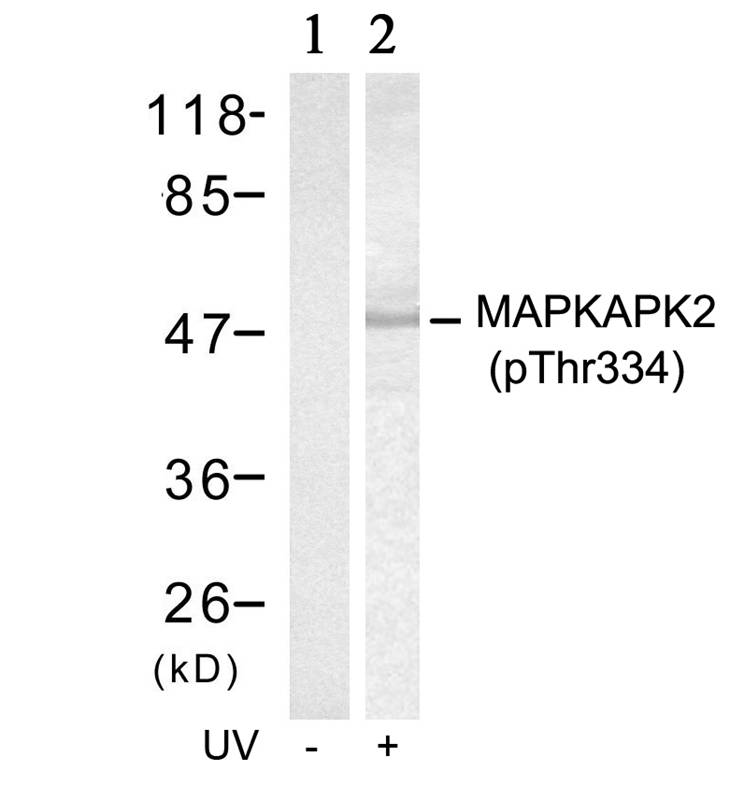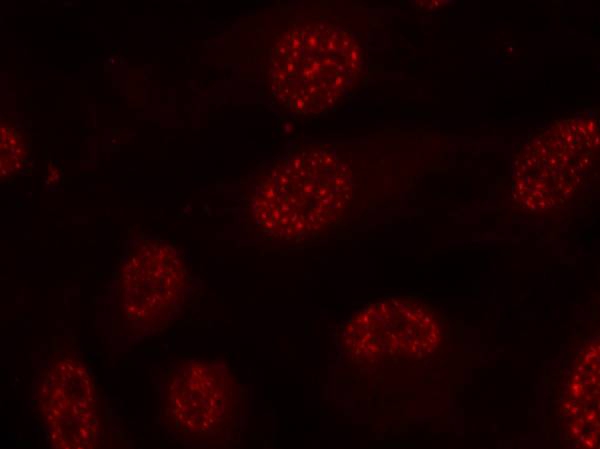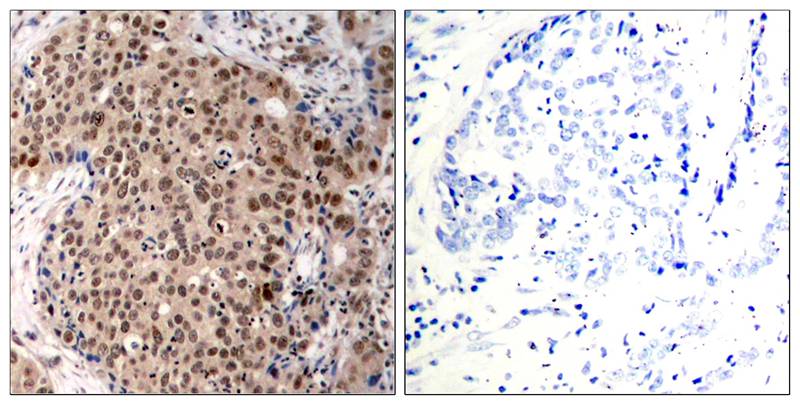


| WB | 咨询技术 | Human,Mouse,Rat |
| IF | 咨询技术 | Human,Mouse,Rat |
| IHC | 1/50-1/100 | Human,Mouse,Rat |
| ICC | 1/100-1/200 | Human,Mouse,Rat |
| FCM | 咨询技术 | Human,Mouse,Rat |
| Elisa | 咨询技术 | Human,Mouse,Rat |
| Aliases | MAP kinase-activated protein kinase 2; MAPK-activated protein kinase 2; MAPK2; MAPKAP kinase 2; MAPKAPK-2 |
| Entrez GeneID | 9261; |
| WB Predicted band size | 49kDa |
| Host/Isotype | Rabbit IgG |
| Antibody Type | Primary antibody |
| Storage | Store at 4°C short term. Aliquot and store at -20°C long term. Avoid freeze/thaw cycles. |
| Species Reactivity | Human,Mouse,Rat |
| Immunogen | Peptide sequence around phosphorylation site of threonine 334 (P-Q-T(p)-P-L) derived from Human MAPKAPK-2. |
| Formulation | Purified antibody in PBS with 0.05% sodium azide. |
+ +
以下是关于MAPKAPK-2 (Phospho-Thr334)抗体的参考文献示例,包含文献名称、作者及摘要内容概括:
1. **文献名称**:*p38 MAPK-dependent phosphorylation of MAPKAPK-2 (Thr334) regulates its subcellular localization and function*
**作者**:Rousseau S. et al.
**摘要**:研究揭示了p38 MAPK对MAPKAPK-2在Thr334位点的磷酸化调控其核质穿梭的机制,并利用Phospho-Thr334抗体验证了该修饰在细胞应激反应中对底物(如HSP27)活化的必要性。
2. **文献名称**:*Role of MAPKAPK-2 phosphorylation in TNF-α-induced inflammatory response*
**作者**:Kotlyarov A. et al.
**摘要**:通过Phospho-Thr334抗体检测发现,LPS刺激巨噬细胞后,MAPKAPK-2在Thr334位点的磷酸化显著增强,并介导促炎因子(如IL-6)的生成,表明其在炎症信号通路中的关键作用。
3. **文献名称**:*Development of a phosphospecific antibody for MAPKAPK-2 Thr334 and its application in cancer models*
**作者**:Meng X. et al.
**摘要**:该文献报道了一种高特异性Phospho-Thr334抗体的开发与验证,证明其在乳腺癌组织中可特异性识别活化的MAPKAPK-2.并与患者预后不良相关,提示其作为治疗靶点的潜力。
4. **文献名称**:*Inhibition of p38-MAPKAPK-2 pathway attenuates cardiac fibrosis via Thr334 phosphorylation modulation*
**作者**:Liu Y. et al.
**摘要**:研究利用Phospho-Thr334抗体证实,抑制p38-MAPKAPK-2通路可降低心肌成纤维细胞中Thr334磷酸化水平,从而减轻纤维化标志物表达,为心血管疾病治疗提供新策略。
(注:以上文献为示例,实际引用需根据具体研究检索真实文献。)
The MAPKAPK-2 (Mitogen-Activated Protein Kinase-Activated Protein Kinase 2), also known as MK2. is a serine/threonine kinase downstream of the p38 MAPK signaling pathway. It plays a critical role in cellular responses to stress, cytokines, and growth factors, regulating processes such as inflammation, apoptosis, and cell cycle progression. Phosphorylation at Thr334 is a key post-translational modification required for MK2 activation. This site is targeted by p38 MAPK, which phosphorylates Thr334 along with Thr222. inducing conformational changes that enhance MK2 enzymatic activity and substrate recognition. Phosphorylated MK2 then translocates to the cytoplasm to modulate downstream targets, including heat shock proteins (e.g., HSP27) and transcription factors (e.g., CREB), influencing mRNA stability and protein synthesis.
Antibodies specific for MAPKAPK-2 phosphorylated at Thr334 (Phospho-Thr334) are essential tools for studying the activation status of the p38 MAPK/MK2 signaling axis in experimental models. They enable detection of MK2 activation in response to stressors like oxidative stress, osmotic shock, or inflammatory cytokines (e.g., TNF-α, IL-1β). These antibodies are widely used in techniques such as Western blotting, immunofluorescence, and immunohistochemistry to investigate MK2's role in diseases linked to chronic inflammation, cancer, and neurodegenerative disorders. Specificity for the phosphorylated form ensures accurate assessment of pathway activity, distinguishing active MK2 from its inactive state. Validation typically includes knockout controls or phosphatase treatment to confirm target recognition. Researchers utilize these antibodies to explore therapeutic strategies targeting the p38/MK2 pathway in conditions like rheumatoid arthritis, sepsis, or ischemic injury.
×